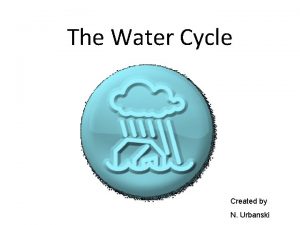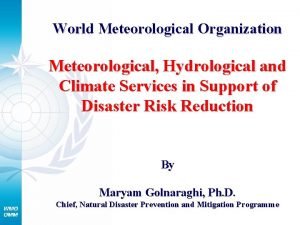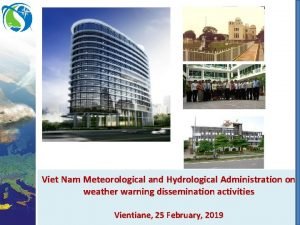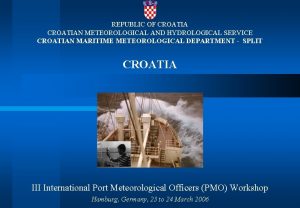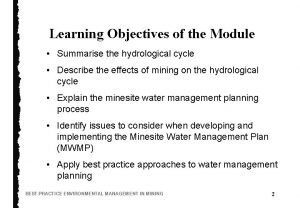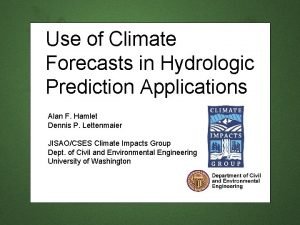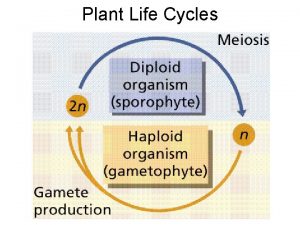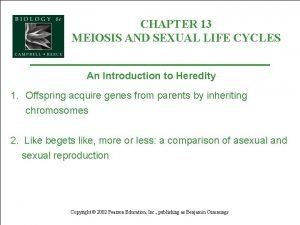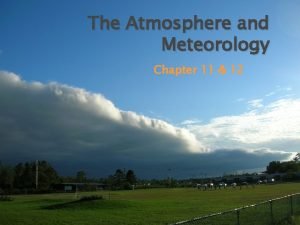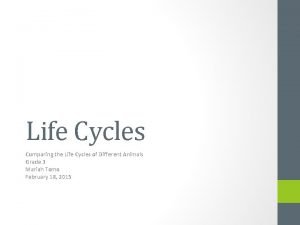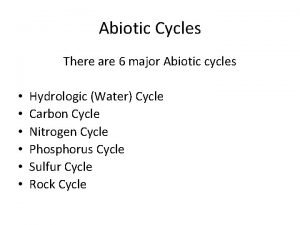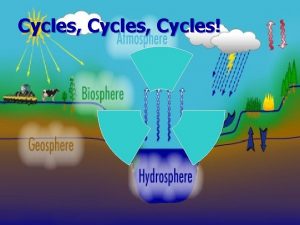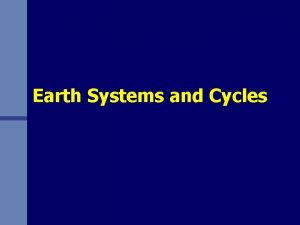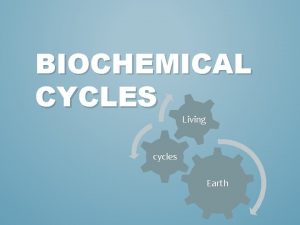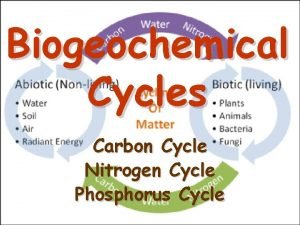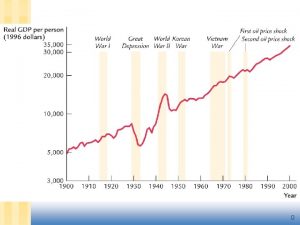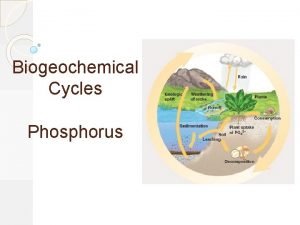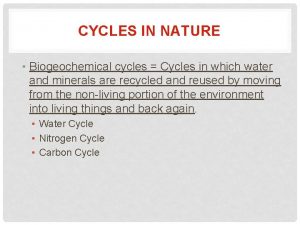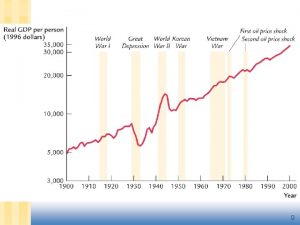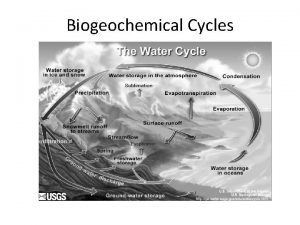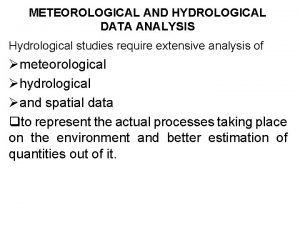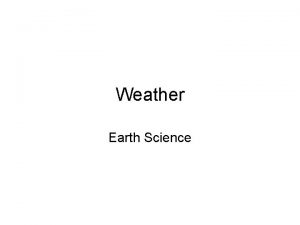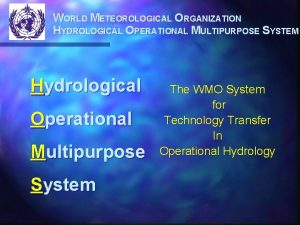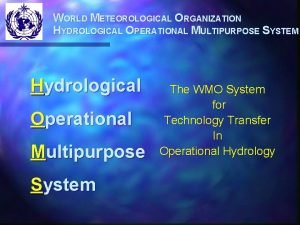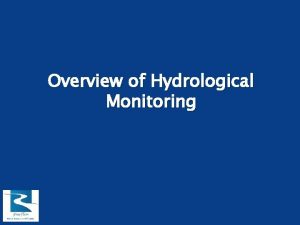Cycles of the Earth Hydrological Cycle and Weather
































- Slides: 32

Cycles of the Earth

• • • Hydrological Cycle and Weather Climate Chemical Cycles Ice Ages Rock Cycle Geological Time Scale

Hydrological Cycle

Taxonomy of Clouds Luke Howard (1772 -1864), Britain

Fitzroy and the Weather Forecast • In the British Navy and responsible for weather reports • Coined phrase Weather Forecast • Convinced that barometer readings foretell tomorrow’s weather • Committed suicide after he was ridiculed by the press and the Admiralty dropped the need forecasting Vice-Admiral Robert Fitzroy (1805 -1865), Britain

High and Low Pressure

Cyclonic Circulation

Collision of Air Masses

Ocean Currents

Movement of the Air Hadley cell named for George Hadley (1685 -1768) tried to explain why trade winds seemed to flow to the west

Climate Conveyor

Global Climates

El Niño & Gilbert Thomas Walker 1868 -1958; England & India

Chemical Cycle: Carbon

Chemical Cycle: Oxygen

Chemical Cycle: Nitrogen

Ice Ages

Evidence of Glacial Action • • Moraines Glacial Till and Flour Erratics U-Shaped Valleys Jean Louis Rodolphe Agassiz (1807 -1873); Switzerland USA Proposed Europe had been subjected to an Ice Age (18371840)

Svante August Arrenius • Developed theory of Greenhouse Effect to explain Ice Ages • 1896 calculated how changes in CO 2 concentration could change climates 1859 -1927; Sweden

James Croll • Used the formulas developed by Le Verrier on planetary orbital variations • Developed a theory about orbital variations influencing the amount of snow • Orbital eccentricity should cause ice ages on a 22, 000 year cycle • Largely dismissed by end of the 19 th Century 1821 -1890; Britain (Scotland)

Milutin Milanković • Canon of the Earth’s Insolation: climates of the planets • Explanation of changes in Earth’s climate by interactions of three planetary cycles 1879 -1958 (a Serb) born in Kingdom of Hungary and died in Yugoslavia

Milanković Cycles • Eccentricity of earth’s orbit (Kepler’s theory) has a 100, 000 year cycle from 0. 005 (nearly circular) to 0. 058 (mildly eliptical) • Axial tilt has a 41, 000 year cycle (tilt changing from 22. 1 o to 24. 5 o ) • Precession has a 23, 000 year cycle (suggested by Hipparchus in 130 BCE)

Inference of Climate Based on Temperature Proxies Pollen Tree rings Ice cores Ratio of oxygen isotopes Corals Diatoms and foraminifera

Rock Cycle 1. 2. 3. 4. 5. 6. 7. Magma Crystallization (freezing) Igneous rock Erosion Sedimentation Sediments & sedimentary rock Tectonic burial and metamorphism 8. Metamorphic rock 9. Melting Defined by Hutton and Lyell and modified by John Tuzo Wilson (1908 -1993), Canada. His Ph. D. advisor: Harry Hess Rock cycle explained by erosion and action of plate tectonics

Using Steno’s Laws, attempt to interpret geological strata by relative time

Jean Léopold Nicolas Frédéric Cuvier & Alexandre Brongniart • Together studied geology of Paris basin • Defined concept of faunal succession • Theory of cycle of repeated catastrophes Cuvier (1769 -1832) France Brongniart (1770 -1847) France

William ‘Strata’ Smith • Surveyor • Strata of coal mines and canals • Used principle of faunal succession to define layers • Life’s work: Geological map of England Wales 1769 -1839, England A plate of Smith’s fossils

Roderick Impey Murchison, 1 st Baronet • Independently wealthy, urged by Humphry Davy to turn his focus to science • Became interested in the geology of Wales, England, Alps, Russia, Scotland • Helped define the Silurian, Devonian, and Permian Systems 1792 -1871, Britain (Scotland)

Adam Sedgwick • Cambridge University faculty (ordained in the Church of England) • Defined Cambrian system • Worked with Murchison to define Devonian in England on the system in the Alps • Charles Darwin was his student who helped to define the sequence of Cambrian rocks in Wales 1785 -1873, England

Arthur Holmes • Pioneer of radiometric dating (Uranium-Lead method). Wrote this in a book by the time he was 24. • Provides absolute time to strata • Showed the earth was more than 1 BY old (most geologists had accepted that the earth was only 100 MY old) • Completed the Geological Time Scale in 1944 1890 -1965; England

Geological Time Scale

 Convection water cycle
Convection water cycle Hydrological cycle diagram
Hydrological cycle diagram National meteorological and hydrological services
National meteorological and hydrological services Vietnam meteorological and hydrological administration
Vietnam meteorological and hydrological administration Croatian meteorological and hydrological service founded
Croatian meteorological and hydrological service founded Hydrological
Hydrological Hydrological prediction center
Hydrological prediction center Biogeochemical cycles water cycle
Biogeochemical cycles water cycle Compare and contrast carbon and nitrogen cycles
Compare and contrast carbon and nitrogen cycles Weather model symbols
Weather model symbols Whatever the weather tongue twister
Whatever the weather tongue twister Poem about weather and climate
Poem about weather and climate It's rainy and windy
It's rainy and windy Whether the weather
Whether the weather Heavy weather by weather report
Heavy weather by weather report Capital weather gang weather wall
Capital weather gang weather wall Stockspotter
Stockspotter Fadlife
Fadlife Plant life cycles and alternation of generations
Plant life cycles and alternation of generations Chapter 13: meiosis and sexual life cycles
Chapter 13: meiosis and sexual life cycles Chapter 13 meiosis and sexual life cycles
Chapter 13 meiosis and sexual life cycles Imbalances in earth’s heat energy help to create weather.
Imbalances in earth’s heat energy help to create weather. Mandarin cycles
Mandarin cycles Alliteration words for cycle
Alliteration words for cycle Importance of water cycle
Importance of water cycle Model for improvement
Model for improvement Precession milankovitch cycles
Precession milankovitch cycles Rvguev
Rvguev Transaction cycle flow chart
Transaction cycle flow chart Cpi cycles per instruction
Cpi cycles per instruction Biogeochemical cycles apes
Biogeochemical cycles apes What is the major abiotic reservoir for phosphorus
What is the major abiotic reservoir for phosphorus Biogeochemical cycle quiz
Biogeochemical cycle quiz

